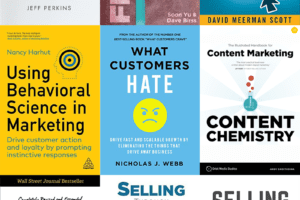Episode 47 of The Verblio Show
What do bees and third party cookies have in common?
Ask Nick Dujnic. From making complicated concepts accessible through entertaining analogies to helping brands rethink the possibilities of email at LiveIntent, his fusion of data and storytelling have made him a self-taught marketing master. In addition to his pop-culture infused videos, our conversation on episode 47 of The Verblio Show covered:
- Why email is becoming even more powerful in a cookie-less world
- The pros of learning on the job vs. formal education
- How to use your email list as a focus group
- Skills he learned as a theater major that he still uses today
- The most valuable piece of first-party data your company can have
- How many t-shirts he has (and where he gets them)
Guest-at-a-Glance
???? Name: Nick Dujnic
???? What he does: VP of Marketing at LiveIntent.
????️ Find Nick on the web: LiveIntent | LinkedIn | Twitter
???? Get smart: “Your email list is like a focus group that you’ve got access to 24/7.”
Top Takeaways
Email isn’t going away ????
Email is one of the oldest channels in digital marketing, but it remains as powerful as ever—and growing. Nick highlights a couple of reasons for this:
- Countries and companies are cracking down on the use of third-party cookies, making first-party data like email addresses even more vital.
- As consumers lose faith in social media and other online content, email remains one of the most trusted digital channels.
The moral of the story? “Always be thinking about capturing email addresses,” Nick says. “It is by far gonna be the most important thing that you can do as a marketer.”
Use email as a focus group ????
While many brands view email as a one-way communication channel—you speak to your audience, but they don’t speak back—the brands LiveIntent works with are leveraging email analytics to learn what their audience truly wants. “Your email list is like a focus group that you’ve got access to 24/7,” Nick explains.
By looking at engagement like open rates and click-through rates, you can see how your marketing is resonating and easily test changes in your messaging. Email also allows you to float product ideas with a targeted group of potential customers to gauge interest before you invest serious time and money building out an idea that may not have real demand..
Episode Highlights
Lessons from a theater degree
“Part of theater is, obviously, reacting off of another person. So I find that the ability to improv and to think creatively is a big thing, especially when you’re in a meeting with other creatives and you’re trying to get juices flowing around ideas, and you’re bouncing things off the wall. That ability to sort of build on and connect with another person’s energy is really important.”
Nick’s (very successful) approach to educating his audience
“The dirty little secret of particularly this space—whether it’s advertising technology or marketing technology—is that very few people fully truly comprehend the deep nuances of it. And they’re afraid to say so because everybody’s afraid that somebody’s gonna call them stupid or that they’re gonna call them out on it in some sort of way. They’re like, ‘I should’ve known that beforehand.’
And my entire approach to our content and our storytelling is like, ‘Nope, nobody’s gonna assume that you know anything along these lines. I’m gonna explain it to you. I’m gonna explain it to you like a human, and I’m gonna talk to you like I would talk to my friends. And I’ll use analogies and I’ll use things that I understand to help you understand this and make it real for you in a way.”
Email as a powerful market research tool
“You don’t need to build out a whole website. You don’t need to create video content. You don’t have to launch a podcast if you wanna garner your audience’s interest in a particular subject or particular product. You can just build out one newsletter, send it to that targeted audience. And then based upon their engagement, their open rates, the click-through rates they’re driving there, you can basically get a good feel. It’s like, are these people who have subscribed to and have opted-in to receive my messaging over and over again—some of my biggest fans—are they into it? Because if they’re into it, that’s probably a good indication that maybe it’s worth investing a little bit more along those lines.”
How LiveIntent determines its content strategy
“We figure out, what are the things that we really need to have our audience understand over time? How does that align with either high level company goals or particular product launches or things like that?
For example, I mentioned we’re launching our native ad solution, so we have a content plan that’s built out around native advertising. So that might mean a video that comes out to explain exactly what native advertising is. And then we may do a Real Time Banter episode talking to a publisher about where native fits into their current direct sold strategy. And then from those two pieces, we break those out into blog posts or interview pieces.”
LiveIntent’s challenge? Expanding what marketers think is possible
“One of our major struggles as a brand was that people understood email newsletter advertising in one way: they would buy them through sponsorships that would get pre-hard coded into it and then sent. They could not wrap their heads around the fact that this was real-time, on open, and that you could do all the types of targeting that you could do online.”
Changes in marketing require more data + more storytelling
“It’s become even more of a data driven push within marketing. It used to be that a marketing budget was just written off as like, ‘The money goes that way and then we’ll figure it out later. And hopefully some of the numbers come back and we’re making more money than we spent.’ And that was sort of the details of it.
But now it’s a far more precise science that goes into it. And you’re responsible for like PNL lines on individual products and things like that, so it gets far more complicated in that way. But in order to illustrate your worth, you have to be a good storyteller. You have to be able to communicate that out, both in front of a crowd or in front of the C-suite, right? You’re constantly having to justify yourself and the budget and the things that are going into there.”
Top Quotes
????️ Nick:
“Ultimately, that’s what marketing is—it’s storytelling. It’s connecting with audiences in a way that makes sense to them.”
“As long as you’re curious enough and you have the capacity to learn, learning on the job is just one of the best things that you can do.”
“There is no better piece of first party data than the email address, and there’s no more effective way to use that email address than through email as a channel.”
“An email newsletter—the thing that’s kind of wonderful about it is, it’s not only very effective but it’s also very cheap.”
“If data’s not informing your storytelling, then you’re not doing it right.”
Learn More
Check out LiveIntentional’s famed “Third-party Cookies as Bees” video, presented by Nick himself.



